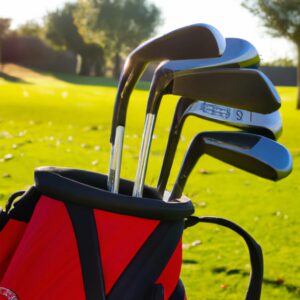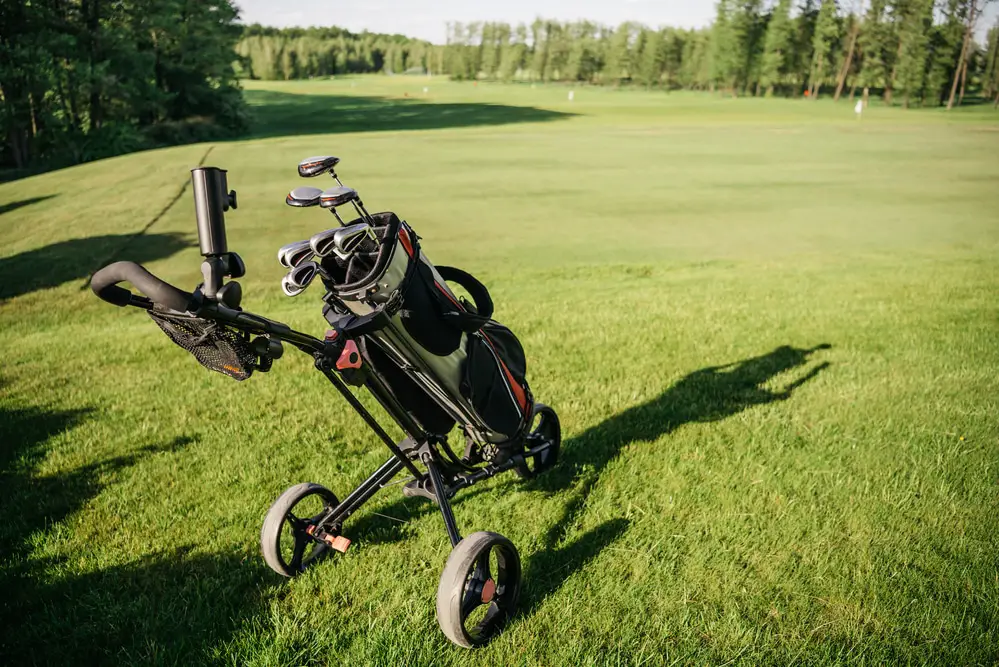Last Updated on June 6, 2023
When it comes to golf, having the right club can make or break a shot. Knowing how to pick the perfect club for any given situation is essential if you want to become an experienced golfer. But with so many options, choosing the best one isn’t always easy. In this article, we’ll discuss tips on selecting the optimal golf club for every type of shot – from drive shots to bunker shots and more! So whether you’re a novice just starting out or an experienced pro looking for some new advice, read on to learn exactly what you need to know about picking the proper golf club.
Considerations for Choosing Clubs
When selecting a golf club, it’s important to consider several factors. Club fitting is one of the most important elements when choosing which golf clubs are right for you. Determining your ideal club type and length will help ensure the best performance from each shot. There are various types of golf clubs that can be used depending on the situation – woods, irons, putters, wedges and hybrids all have different purposes.
Knowing the basics of club selection is key in order to making wise decisions about what equipment should be used in any given situation. A good way to get started is by reading up on some tips and guides regarding club selection; this information can provide an overview of how different clubs work and what their optimal uses are. Additionally, consulting with a professional who specialises in custom fitting or just asking questions at a local pro shop could prove helpful as well.
Grip Size and Type
Grip size and type are two of the most important elements to consider when selecting a golf club for a shot. The right grip will help you maintain proper technique and control over your clubs, as well as allow for an efficient transfer of power from your arms to the ball. Club fitting is recommended to find the ideal grip size and type for each golfer’s individual style. A good rule of thumb is that if it feels too thick or thin in your hands, then chances are it’s not the best fit.
The main types of grips available are ribbed (or corded), rubber and synthetic materials, all-weather rubber, multi-compound, leather wrap, and oversized/jumbo grips. Each type has its own benefits: ribbed grips offer more traction while still being relatively inexpensive; rubber provides increased tackiness; synthetic materials provide durability at a low cost; all-weather rubber works great in wet conditions; multi-compound offers better feel with added resistance; leather wraps can be expensive, but they provide luxurious comfortability; and jumbo grips allow those with large hands to have a secure hold on the club. Ultimately, it comes down to finding the combination that fits both your hand size and playing technique best.
Shaft Flexibility and Length

Now that you have the right grip size and type for your golf shot, it’s time to move on to shaft flexibility and length. Golf shaft flex is determined by a number of factors, including the weight of the golfer, their swing speed and even their age. A good rule of thumb when selecting a shaft is to match your clubhead speed with the correct flexibility rating. For example, if you are an average player with an 85 mph club head speed, then you should use either a regular or stiff shaft, depending on which feels best during practice swings.
When it comes to shaft length selection, there are two main options; standard-length clubs or custom-fit clubs, where adjustments can be made based on the individual’s height and arm length. Standard lengths tend to work well for most players, but those looking for more specific performance may benefit from having each club tailored specifically to them. In this case, it is important to remember that longer clubs will generate more distance while shorter clubs offer better accuracy and control over ball flight direction.
No matter what kind of shaft flex or length you choose, make sure it fits your body type properly so that you can consistently achieve maximum performance out on the course – both in terms of power and accuracy. With a properly fit set of clubs in hand, all that’s left is getting some practice in before hitting the links!
Clubhead Shape and Loft Angle
The golf clubhead determines the overall effect of a shot. It’s important to choose the right one for your particular needs, as each has its own unique shape and loft angle.
When selecting a clubhead, consider these factors:
Shape:
- Traditional blade-style heads are designed for more accuracy and control when hitting higher-lofted clubs.
- Oversized or mallet-style heads provide more confidence on shots that require distance but not necessarily precision.
- A hybrid head is an option between the two, offering both forgiveness and power in one design.
Loft Angle:
- The degree of loft (or “clubhead loft”) affects how far you can hit the ball with any given club.
- Clubs with higher lofts will generate less distance than those with lower lofts—but they may be more accurate if used correctly.
- Experimentation is key here; find out which combination of loft angles works best for your swing style and goals as a golfer.
These choices will affect how well you play–so take some time to get familiar with all of them before making a final decision!
Understanding Lie Angle
Once you’ve selected the right clubhead shape and loft angle for your shot, the next step is understanding the lie angle. This refers to the angle of the shaft in relation to the sole plate when looking down at it from the address position. The correct lie angle will allow you to square up more easily on your target line and also ensure that your ball-to-target line passes through the centre of gravity of your club.
To make sure you get the right lie angle for a given shot, you need to consider where your club is adjusted compared with its standard setting. If it’s too upright or flat relative to its standard setting, then an adjustment may be needed. Club lie can typically be adjusted by 1–2° depending on what type of golf club you’re playing with, so don’t worry about making major changes if necessary. However, this should always be done under expert supervision, as incorrect adjustments could have disastrous effects on your game!
Choosing the Right Set Makeup
Once you know what clubs are needed for a shot, the next step is to choose the right set makeup. Every golfer should have a well-rounded golf set makeup that will help them hit shots from all types of lies and distances. Your club set makeup consists of woods, irons, hybrids, wedges and putters. When choosing your club set makeup it’s important to consider your skill level and playstyle. Beginners may want more forgiving clubs, while more experienced players need more specialised ones.
If you’re not sure what type of clubset would be best for you, seek advice from an instructor or pro shop attendant. They’ll be able to evaluate your swing speed and playing style in order to recommend the right clubs for you. It’s also helpful to try out different models at a driving range before purchasing new clubs so that you can make an informed decision on which clubs suit your game best.
Determining Distance Requirements

When determining the distance requirements for a golf shot, it’s important to consider the distance of both the club and the overall shot. To select the right club for your needs, you’ll need to know how far each type of club can hit. For example, a driver usually has more power than an iron and will travel further down the fairway. It’s also important to consider that terrain can have an effect on your ball’s trajectory and total distance travelled.
Once you’ve determined the amount of distance needed for a particular shot, you can begin selecting clubs accordingly. Keeping in mind that different clubs are designed to reach varying distances, make sure to pick one with enough power behind it to meet your specific needs. Additionally, remember that wind conditions may play a role in affecting your ball’s final resting spot; this should be factored into your club selection as well. With these considerations in place, you’ll be able to choose a club with confidence for any given situation on the course.
Selecting the Right Material
Once you have determined the distance requirements for your shot, it is time to select the right material for your golf club. Club material selection can be a daunting task as there are many types and properties of materials to consider. The most common type of club material is steel, which offers great durability and consistency but lacks in feel compared to other materials such as graphite or titanium. Graphite shafts offer more flexibility than steel while providing excellent feedback from the ball at impact. Titanium provides good levels of power and accuracy with an enhanced feel around the greens.
When choosing between different types of club materials, you should take into account factors like swing speed, balance preferences, and budget constraints that may affect how well each option will perform on the course. Additionally, research any reviews available online so you can make an informed decision when selecting your next golf club. With this knowledge in hand, you’ll be able to find a club that meets both your needs and expectations on the course.
Weight Distribution of the Clubhead
The weight distribution of a clubhead is an important factor to consider when picking the right golf club for a shot. The total clubhead weight, or its centre of gravity, will affect how well it performs in your swing. To ensure you pick the best club for your needs, it’s essential to understand how different weights are distributed throughout the head and shaft of the golf club.
One way to measure this is through swing weight. This metric measures the relative amount of effort required to swing clubs with different heads and shafts. A higher swing weight means that more force is needed to move the head through impact and follow-through during your golf swing. Here’s a table that compares typical swing weights:
| Club Head Weight (g) | Swing Weights (C9-F2) |
|---|---|
| 200 | C9 – D1 |
| 250 | C7 – E0 |
| 300 | C5 – F2 |
It’s also important to note that each manufacturer has their own specifications on where they place the centre of gravity within their clubs’ heads. Knowing which locations allow for optimal performance can help you make an informed decision about which type of club will work best for your game style. Understanding these concepts should give you all the information necessary to choose a golf club with confidence!
Practising With Different Clubs
Now that you understand the importance of weight distribution in golf clubs, it’s time to start practising with different clubs. Practising with multiple clubs is essential for selecting the right club for a particular shot. Here are three ways to practice:
- Experiment with the distance each club can hit the ball and which one works best depending on how far away from the green you are.
- Take shots at different angles and slopes so you get comfortable playing off the uneven ground.
- Practice hitting targets or flags for precision accuracy when working on your game.
By using these methods, you’ll be able to gain an understanding of each club’s capabilities and become more confident in your selection before taking a shot. With that said, regular practice will help you perfect your skillset and make sure you always pick the right golf club for any situation!
Customisation Options for Clubs
When it comes to golf clubs, customisation is key. There are a variety of ways that you can customise your clubs so that they fit your needs and style perfectly.
| Customising Clubs | Club Fitting |
|---|---|
| Lie Angle | Loft & Length |
| Shaft Flexibility | Grip Size & Feel |
| Weight Distribution in Head | Swing Weight |
When customising clubs, lie angle is the most important factor as this affects where the clubhead will contact the ball on impact. The loft and length of the club also need to be considered when fitting a club for yourself or someone else. Additionally, shaft flexibility plays an important role in performance since different flexes will produce varying trajectories and spin rates. Furthermore, weight distribution within the head, along with grip size or feel, should also be taken into account during customisation processes. Lastly, swing weight must not be overlooked either, as it determines how easy or difficult it will be to control swing speed and shot accuracy.
In summary, there are many options available to customise golf clubs according to individual preferences. Adjusting factors such as lie angle, loft/length, shaft flexibility, weight distribution in the head, grip size/feel and swing weight can all improve one’s game tremendously if done correctly. As long as these elements are carefully evaluated prior to the purchase or assembly of a set of clubs, golfers can enjoy more successful rounds on their favourite courses.
Frequently Asked Questions
What Are the Advantages and Disadvantages of Different Materials for Golf Clubs?

When it comes to selecting the right golf club for a shot, one of the main considerations is the material that goes into making up the clubs. Different materials offer different advantages and disadvantages depending on the specific needs of each golfer, so understanding these properties can help make sure you pick the right one.
The most commonly used materials in golf clubs are steel and graphite. Steel offers more control over your shots due to its stiffness and heavier weight compared to graphite, so if accuracy is key, then this could be an ideal choice. Graphite shafts tend to provide increased distance as they are lighter than steel but may lack some precision when hitting longer irons or woods due to their flexibility. It’s important to keep in mind that there are other less common materials, such as titanium or composite, that also have unique characteristics which should be taken into account when deciding what type of club will best suit your game.
So when considering a club selection based on material properties, take into consideration how far you need the ball to go and whether accuracy is more important than distance. Additionally, think about any potential risks associated with using certain types of materials – for example, steel shafts can cause vibration through impact, whereas graphite ones can provide a more cushioning feel against your hands during swings. Ultimately by assessing all factors involved in choosing a golf club material, you’ll be able to find one that works best for you!
Is Customisation of Golf Clubs Worth the Extra Cost?
Customising golf clubs can be an expensive investment, but is it worth the extra cost? Golf club fitting and customising a set of clubs for individual specifications often comes with a higher price tag than buying off-the-rack. However, there are many benefits to having a customised set that could outweigh the cost.
When selecting a new golf club, customisation provides more options in terms of design and materials used. Taking into account the golfer’s unique swing characteristics, such as speed, tempo, and even posture, can lead to better performance on the course. A professional fitter will look at all aspects of your game before making any recommendations on what type of clubs would best suit you – this includes shaft length, grip size, loft angle, etcetera. With this level of personalisation available through custom clubs, golfers may find an improvement in their overall accuracy during play.
In summary, although customising golf clubs does come with additional expense compared to purchasing ‘off-the-shelf’, considering how much control over one’s own club selection it offers and how tailored each component can be to fit individual needs; it is worth looking into when seeking out the perfect set for yourself or someone else.
Conclusion
Choosing the right golf club for a shot can be challenging, but with practice and knowledge of the different options available, it doesn’t have to be. Understanding shaft flexibility and length, as well as distance requirements for each shot, will help you make an informed decision when selecting your clubs. Additionally, being aware of the advantages and disadvantages of materials used in golf clubs will help you decide if customisation is worth the extra cost. Taking these factors into consideration will ensure that every time you step up to hit a ball, you are confident in your selection of club and know that it’s going to give you the best chance of success. With this in mind, practising with different clubs regularly will allow you to become familiar with them so that picking out the correct one becomes second nature – making sure that when it comes down to crunch time on the course, you won’t hesitate before taking your shot.


